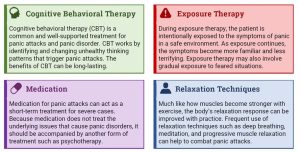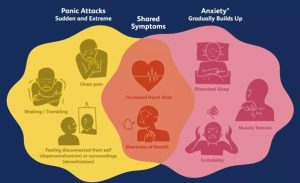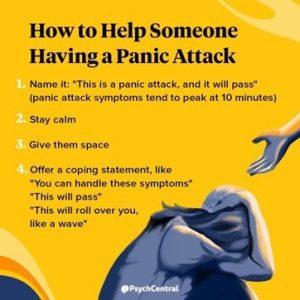Coping with Panic Attacks

A recent theme amongst students accessing Student Services support is reports of panic attacks. Considering this, I thought it would be helpful to provide some more information on what a panic attack is (and is not).
A panic attack is a sudden surge of overwhelming fear or intense discomfort that reaches a peak within minutes. During panic attacks, people often fear that they are having a heart attack, that they cannot breathe, or that they are dying. The intensity of a panic attack goes well beyond normal anxiety, and can include several physical symptoms, including:
- Palpitations, pounding heart, or accelerated heart rate
- Sweating
- Trembling or shaking
- Sensations of shortness of breath or smothering
- Feelings of choking
- Chest pain or discomfort
- Nausea or abdominal distress
- Feeling dizzy, unsteady, light-headed, or faint
- Chills or heat sensations
- Paraesthesia (numbness or tingling sensations)
- Derealization (feelings of unreality) or depersonalization (being detached from oneself)
- Fear of losing control or ‘going crazy’
- Fear of dying
TherapistAid.com provides the following information on panic attacks:
Panic Attack Facts
- Panic attacks may feel scary, but they don’t actually cause physical harm. The most common fears associated with panic attacks (having a heart attack or fainting) are not actually a threat.
- Panic attacks are usually brief but intense. The symptoms of panic typically peak within 10 minutes, and end within 30 minutes. However, some lingering symptoms can last over an hour.
- Panic attacks can seem to occur randomly, or they can be closely linked to a specific source of anxiety such as driving, crowded places, or simply leaving home.
- Panic disorder occurs when a person has frequent worry or fear of future panic attacks, or when they change their behaviour in order to avoid attacks (such as avoiding a feared situation).
- Panic attacks are not a mental disorder in themselves but can occur in the context of any anxiety disorder as well as other mental disorders (e.g., depressive disorders, posttraumatic stress disorder, substance use disorders) and some medical conditions (e.g., cardiac, respiratory, vestibular, gastrointestinal).
How are Panic Attacks treated?

Panic Attacks vs Anxiety
Verywellmind.com provides the following visual to distinguish between panic attacks and anxiety:

As depicted in the picture above, Sheryl Ankrom, MS, LCPC explains in verywellmind.com that anxiety generally intensifies over a period of time and is highly correlated with excessive worry about some potential danger — whether real or perceived. If the anticipation of something builds up and the high amount of stress reaches a level where it becomes overwhelming, it may feel like an ‘attack’. The symptoms of anxiety may include the following:
- Mental Symptoms, e.g., difficulty concentrating, irritability, restlessness, etc.
- Physical Symptoms, e.g., disturbed sleep, dizziness, fatigue, increased heart rate, increased startle response, muscle tension, etc.
While some of the symptoms of anxiety are similar to those associated with panic attacks, they are generally less intense. Unlike a panic attack, the symptoms of anxiety may be persistent and very long-lasting — days, weeks, or even months.
Responding to Panic Attacks
In his Panic Attacks Workbook, David Carbonell, PhD, suggests following the AWARE steps outlined below to most effectively respond to panic attacks:
AWARE Steps
A: ACKNOWLEDGE & ACCEPT
I observe my symptoms of fear and work with them. I don’t try to ignore, deny, fight, or flee them.
W: WAIT & WATCH
I’m just a passenger. I observe and journal my thoughts and reactions while I wait to arrive at my destination.
A: ACT
I don’t need to make the fear stop. That will happen no matter what I do. I just need to wait. If I can make myself more comfortable while waiting for the fear to pass, maybe with deep breathing or journaling, I can also do that.
R: REPEAT
When I experience repeated flurries of fear, I’ll just take these steps from the top.
E: END
The fear will end even when I think it won’t. All I need to do is wait, because I’m a passenger, not a pilot.
Here are a few additional ideas (adapted from The Panic Deck cards by Elena Welsh, PhD) for practices to use during the ACT step which could help in finding some relief in the moment while you wait for the panic attack to pass. Not all of these would be helpful for everyone, so only trial the ones which resonate with you:
- Breathing exercises, such as deep, slow controlled belly breathing, box breathing, 4– 7–8 breathing, or download one of the many breathing apps available to guide you.
- Use calming coping statements like “This cannot harm me,” “I’ve been through this before,” “I am safe,” “This too shall pass,” “I don’t have to believe everything my anxiety tells me,” etc.
- Do a grounding exercise: Look around you and identify and name:
- 5 things you can see (name the colour and shape of each object)
- 4 things you can touch (and physically touch them, experience the different textures)
- 3 things you can hear (close your eyes and listen carefully)
- 2 things you can smell (you can smell your own clothes, hair, or other objects)
- 1 thing you can taste (you would most likely notice the last thing you had to eat or drink)
- Physical grounding:
- Self-massage: e.g. use your thumb to massage the palm of your hand and/or forearm or massage your neck in a circular motion.
- Progressive muscle relaxation: tighten and relax each of your muscle groups, one at a time, starting with your toes and finishing with the muscles in your face.
- Tapping on various acupressure points, such as the eyebrow, side of the eye, under the eye, under the nose, chin, beginning of the collarbone, right below the armpit under the arm seven times in a downward sequence while repeating the statement, “Even though panic scares me, I accept my experience.”
- Drink a glass of water.
- Change in temperature: Hold an ice cube or splash cold water on your face.
- Change the scenery by switching rooms or going outside or inside (depending on where you are).
- Listen to music and sing along.
- Look for signs of safety around you.
- Mental grounding:
- Spell your name backwards or read text from a book or article backwards.
- Pick a category (e.g., names, towns, animals, sports, fruit, songs, bands, etc) and name as many things you can think of in that category using the alphabet and the letter it starts with.
The following visual from psychcentral.com provides some helpful suggestions on how we can best respond to others when they experience a panic attack:

Panic attacks can be scary to experience or to observe in others, but it is important to understand that they are not dangerous, just extremely uncomfortable!
Until next time,
Marisa Smit
CGS Psychologist

 497
497











